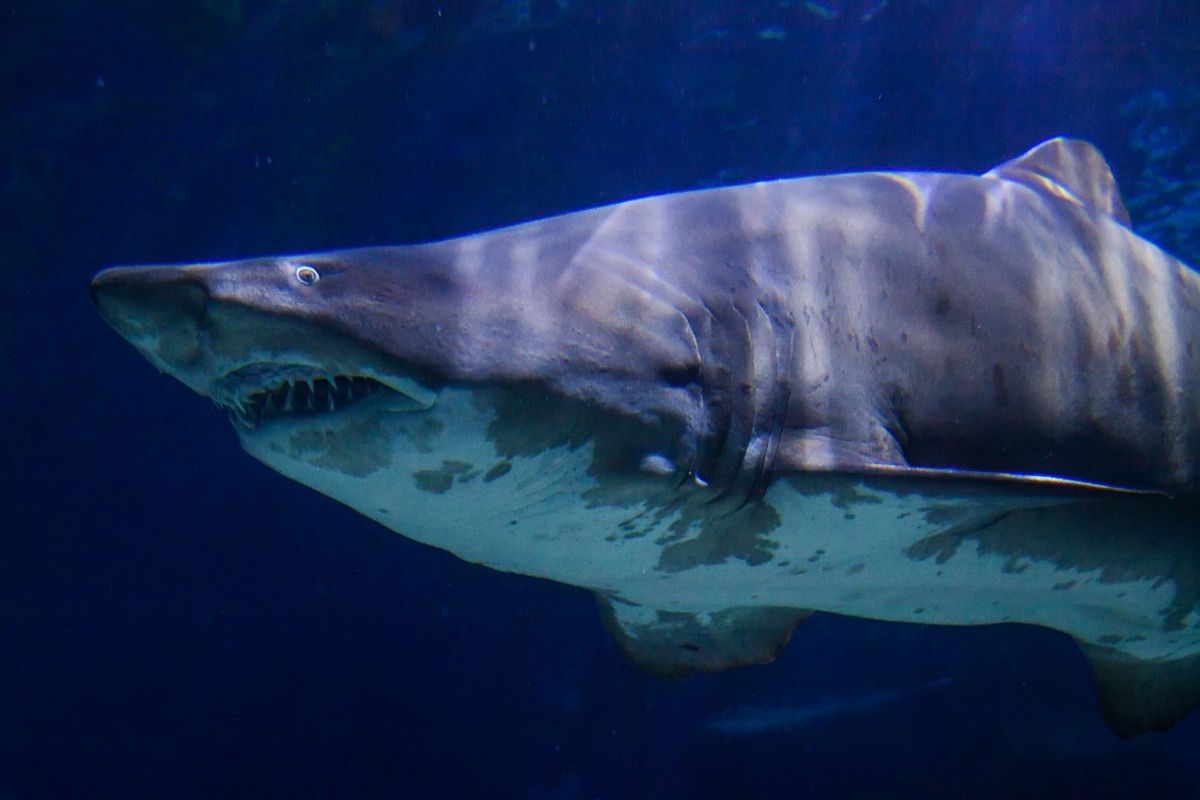Of all the monsters which used to roam the Earth, the undisputed king of the oceans was the Megalodon.
Existing as an apex-predator to many other now extinct species of ancient creatures for millions of years, this monster-sized shark has inspired awe and terror into all those that have stumbled upon its remains- tokens from a period of pre-history beyond our imaginations.

It can be difficult to imagine the size of ancient life in our comparatively low-oxygen world; and the clues left behind for us to follow are few and far between, and sometimes not altogether clear.
A discovered giant bone or tooth can set the imagination on fire, but what can tell us about the past in certainty?
As technology improves and more fossils are discovered, palaeontologists are only now just beginning to understand the sheer scale of these massive creatures- and we attempt to take it all in below:
Megalodon Shark Size
According to the most recently available data, scientists have determined that the average length of a megalodon shark was likely between 60 and 70 feet from tip to tail.
They also estimate that a fully grown average megalodon could have weighed as much as 50-70 tons.
For reference, the biggest shark species that exists today, the Great White, is only about 21 feet long and weighs about 3.5 tons.
Compared to the modern shark, Megalodons were more than just huge; they were actual sea monsters.
These estimates are based on the numerous fossils that have been collected of megalodon specimens.
Megalodons spanned a massive period of prehistoric history- they existed in both the Miocene and Pilocene epochs, meaning that their existence lasted for many millions of years.
This is much, much longer than human beings have existed.
-The Miocene epoch spanned from 23 million years ago to 5.3 million years ago.
-The Pilocene epoch spanned from 5.3 million years ago to 2.6 million years ago
Megalodon Size Comparison To Human
Probably the first thing you’ll wonder when considering the scale of a truly massive shark- just how you would fare if you were ever caught out in a Miocenic ocean with one.
Well you can put all those questions to rest:
The megalodon would have popped you back like a potato chip.
The dorsal fin of a megalodon alone was about 5 foot 3 inches, which might already have you sweating if you’re a bit on the shorter side.
If that hasn’t set your imagination off, then this might: the megalodon tail was far taller than any human being, more than twice so.
At 13 feet, the tail measures in at about half the length of a London double-decker bus.
And we haven’t even started on the scary part of a shark yet.
Megalodon Jaw Size
Move over Jaws- if you’re still wondering whether this beast would have been able to take you, know that the mouth of a megalodon extended seven feet long, enough to fit any human.
You might even have seen this for yourself if you’ve been to a natural history museum lately- many have a replica megalodon jaw as the centerpiece of their exhibit for people to get photos next to.
Being swallowed whole by the megalodon would have been a merciful blessing however- in reality, megalodons had extremely powerful jaws much like sharks of today, and boasted five rows of over 250 razor sharp teeth.
These were alpha predators which scourged the seas for millions of years.
Truly understanding the jaws of a megalodon in the past because, like other sharks, megalodon jaws were made of cartilage.
Cartilage decomposes rather quickly and is therefore unlikely to leave a fossil to give clues as to the size and shape of the jaws.
Most of what we have relied upon in the past in regards to megalodon mouths comes from their many, many teeth- which are made of tooth enamel and therefore preserve quite well.
Megalodon Tooth Size
Let’s not gloss over those teeth- all over 250 of them. Just one single megalodon tooth weighed more than a pound – that’s more than 900 of your pathetic human teeth.
These dense, heavy teeth were often over seven inches long each and far outstripped the infamous teeth of our modern friend The Great White- which sometimes graze 2 inches long.
The mouth of a megalodon is, in short, hell on Earth.

Megalodon Diet
So what was the prey of this mighty monster for their millions of years on Earth- while they waited fruitlessly for tasty humans to exist?
Megalodons were an apex predator- they may even have been THE apex predator of their time, which meant they got their teeth into just about everything.
This would have included mammals like earlier dolphins or whales, as well as fish- which also included other shark species too!
Megalodons favoured warmer and more temperate waters as their hunting grounds- which we know because their remains are found on every continent’s ocean apart from Antarctica.
The richer bounties of these waters would have been perfect for sustaining this massive creature’s hunger.
Megalodon Breeding
As megalodons are no longer around, all the clues that we have to understand their biology are based upon their limited fossilised remains.
It is therefore difficult to determine just exactly how they reproduced- although we can get much insight from looking at the shark species which exist today.
Modern sharks reproduce via either ovoviviparity methods or vivipary methods depending on the physiology of their species.
-The ovoviviparity method is when offspring develop within eggs within the mother herself. The eggs hatch within the mother, and the offspring are released.
– The vivipary method is the same method by which humans and other mammals reproduce: offspring develop within the mother as an embryo, and are then ‘born’ from the mother.
Megalodon vs. Blue Whale Size
So we know how the megalodon became the apex predator of the seas in its day, but how does it compare to the largest sea-dwelling creature of our time: the mighty Blue Whale?
In a size is best argument, you may be surprised to learn that the Blue Whale actually outstrips the ancient sea monster.
Palaeontologists estimate that the weight of a Megalodon was about 227,000 pounds on average- very hefty, don’t get us wrong- but Blue Whales can weigh 290,000 pounds minimum.
The record for the largest Blue Whale ever found was about 418,000 pounds, much larger than even the largest discovered megalodon.
In terms of length, the Blue Whales also slightly have the edge- the largest of which pip the largest Megladons by around 20 feet, at 110 feet.
Not to get all playground, but who would win in a fight?
Well in this case, the Megs clearly have the advantage- their enormous jaws which brimmed over with teeth gave them the advantage for millions of years.
In contrast, Blue Whales are very passive and eat huge amounts of tiny krill.
In a way, the extinction of the Megalodon paved the way for the Blue Whale. With the apex predator out of the way, Baleen Whales were able to evolve into the massive carefree whales of today.
Carefree until humans came along, that is.
Megalodon vs. Great White
Great White Sharks are the most recognisable and biggest sharks around today, so perhaps it will comes as no surprise that they are related.
In their own eco-systems, both existed as the apex predator. If they had both existed concurrently however, the Megaladon would have dominated the Great Whites- at an estimated 50 times the size of today’s apex shark.
Compared to the tremendous weight of a Megaladon, the Great White weighs in at a mere 5,000 pounds on average.
While the Great White is also considered a great predator due to its incredible agility (the Great White is twice the speed of its closest rivals, the Basking and Tiger sharks), it is believed that the Megalodon was twice its speed again.
In Summary
If you take anything away from these comparisons of the sheer size of the Megalodon, let it be this: just be glad it isn’t around today.
Some people see the great vastness of the ocean and its unknown depths, and insist that there is no reason that Megalodons or other massive sharks couldn’t exist out there somewhere- but scientists unanimously discount the probability of ever finding evidence of recently living mega-sharks.
All that remains of the Megalodon today are the shapes of their ancient remains preserved in fossils, and their smaller kin, made in their own image.
- Is It Possible For A Shark To Swim Backwards? - August 2, 2022
- Are Leopard Sharks Dangerous? - August 2, 2022
- What Are The Differences Between Shark And Dolphin Fins? - August 1, 2022








